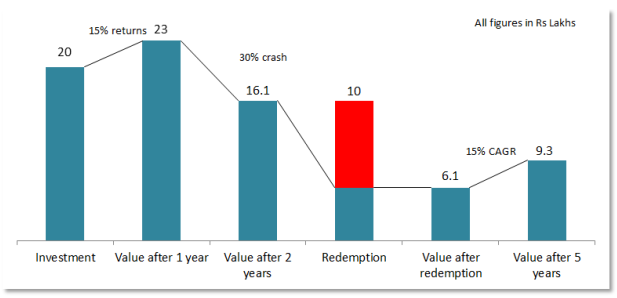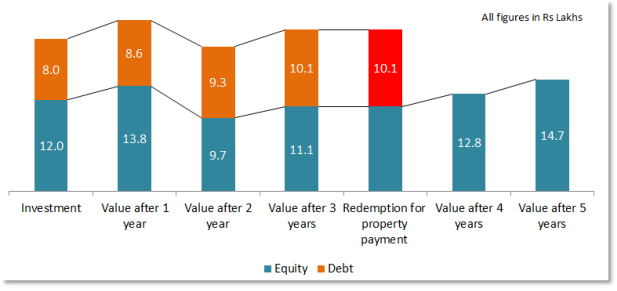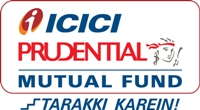Importance of Asset Allocation in volatile markets

Though the stock market had a great run for the last few years, this year the market has turned volatile. The Nifty 50 index has fallen around 10% in the last two months and more cuts in the near term are possible. The midcap and the small cap segment of the market saw the most brutal cuts in 2018. The Nifty Midcap 100 index has fallen around 24% this year, while the Nifty Small Cap 100 index has fallen more than 35%. It is natural for investors who have invested in equity mutual funds in the last one year or so, particularly ones who have invested in midcap / small cap funds, to feel worried about their investments.
Did you know the 10 things you should do when the markets are volatile?
Volatility is an intrinsic characteristic of equity as an asset class. It is the risk associated with volatility which makes equity the best performing asset class in the long term; if you cannot take risk, you will have to satisfy yourself with lower returns. In the last 20 years, Nifty 100, which is the index of large cap stocks, has given nearly 18% annualized returns despite at least four bear markets in the interim, each of which saw more than 20% corrections. Over the same period (last 20 years), safer asset classes like Gold and bank FDs have given only 10% and 7% returns respectively.
The superior outperformance of equity in the long term notwithstanding, volatility is stressful for investors, particularly for those, who do not have much experience in investing or those who do not have high risk appetites. Volatility can also be troublesome for investors who do not have very long investment tenors. In our view, investors should have a minimum investment horizon of 5 years for investing in equity mutual funds. If your investment tenor is shorter or if you are nearing a financial goal time-line then volatility, or a big crash may cause a substantial reduction in your investment value, from which you may not have sufficient time to recover.
How to balance risk and return?
Investors can balance risk and reward by allocating their investments to different asset classes (with different risk / return profiles); in finance parlance this is known as Asset Allocation. The essence of asset allocation is in the English idiom – do not put all your eggs in one basket. Asset is the percentage mix of different asset classes like debt, equity, real estate and gold in your total asset or investment portfolio.
In its simplest form asset allocation often refers to the percentage split between debt and equity investment. However, asset allocation includes asset classes like gold and real estate as well. Different asset classes outperform or underperform in different parts of investment cycles. For example, equity outperforms debt during bull markets and debt outperforms equity during bear markets. If you invest in a hybrid asset class, which comprises of both debt and equity investments, then you will achieve relative stability in your portfolio, across different market conditions.
Importance of Asset Allocation
Let us understand the importance of asset allocation in reducing the impact of market volatility on your investment with the help of couple of examples. Suppose you have Rs 20 lakhs for investment and you need Rs 10 lakh in 3 year’s time to make the down payment for a property investment.
Did you know how to achieve financial goals through right asset allocation
Scenario 1 - You invest 100% in a pure equity
Let us assume that you get 15% return in year 1 and then see a 30% crash in year 2, which sees your investment fall in value to Rs 16 lakhs. Since you need minimum Rs 10 lakh for the property investment in year 3, you do not take a risk and redeem Rs 10 lakhs of your investment. The balance amount will remain invested in equity. Let us see how much your investment grows to in 5 years, assuming 15% CAGR returns from year 3 onwards. You can see that your portfolio value after 5 years would be Rs 9.3 lakhs.

Scenario 2 - You invest 60% in equity and 40% in debt
Out of your investment of Rs 20 Lakhs, you invest Rs 12 lakhs in equity and Rs 8 lakhs in debt. Let us assume debt gives you 8% annualized return in 3 years. Equity like in scenario 1, gives 15% return in year 1, falls 30% in year 2 and gives 15% CAGR returns from year 3 onwards.
Did you know what is a reasonable rate of return from equity mutual funds
Let us see how much your investment grows to in 5 years. You can see that your portfolio value after 5 years would be Rs 14.7 lakhs.

The second scenario is clearly better because your investment value at the end of 5 years is almost Rs 5 lakhs higher compared to Scenario 1.
Learn how you can get more returns from your mutual fund investments
Asset allocation provided downside protection to your portfolio from downside market risk and provided liquidity for your medium term requirement (property purchase), while equity provided you long term capital appreciation. If you had a 7 to 10 years or longer investment tenor, Scenario 1 would likely have yielded better results, but since you needed liquidity in the interim and given unpredictable nature of the equity market, Scenario 2 gave far better results. Hopefully with these two examples, we have been able to elucidate the importance of balancing risk, return and liquidity.
You must know why you should not ignore investing in debt mutual funds
How to determine your right asset allocation?
Your optimal or right asset allocation depends on a number of factors:-
- Your long term, medium term and short term goals. Did you know what could be the simple asset allocation strategies for different risk profiles
- Your investment tenor / goal timeline
- Your risk capacity – age, income, investment experience, your individual volatility tolerance. You may like to read – Are you risk averse: Understand your risk capacity
- Your Short to intermediate term liquidity needs
How to achieve asset allocation?
You can achieve asset allocation by investing in a mix of equity and debt assets – these can be equity and debt mutual funds. For example, if you want an asset allocation of 60:40 (equity: debt), you can invest 60% of your funds in different equity mutual fund schemes and 40% of your funds in different debt mutual fund schemes.
You must read about asset allocation and market cycles
Hybrid funds are mutual fund schemes which invest in both equity and debt (and sometimes gold also). Investment objectives of these funds are to achieve capital appreciation over a sufficiently long investment horizon and at the same time, containing downside risks. There are different types of hybrid funds which have different asset allocation profiles ranging from aggressive (high equity percentage, 65 to 80%) to conservative (low equity percentage, 10 to 25%). Different types of hybrid funds have different investment strategies to cater to different investment needs. Hybrid funds offers wide range of solutions to a broad spectrum of investment needs.
Conclusion
In this blog post, we discussed how asset allocation can optimize risk and return for investors. The beneficial effects of asset allocation can be seen in volatile markets; asset allocation provides portfolio stability in such market conditions. In this post, we also discussed how hybrid mutual funds are ideal and very convenient investment solutions for achieving your desired allocation.
In our next post, we will discuss about different types of hybrid mutual funds and suitability of different hybrid funds for your individual investment needs and risk appetites.
Mutual Fund Investments are subject to market risk, read all scheme related documents carefully.
RECOMMENDED READS
LATEST ARTICLES
- Why you need to have hybrid mutual funds in your portfolio: Different types of funds Part 2
- Why you need to have hybrid mutual funds in your portfolio: Misconceptions Part 1
- Which is the best time to invest in mutual funds
- Economic slowdown: Is it real and what should you do
- Importance of liquidity in investing: Mutual funds are ideal solutions
An Investor Education Initiative by ICICI Prudential Mutual Fund to help you make informed investment decisions.
Quick Links
Follow ICICI Pru MF
More About ICICI Pru MF
POST A QUERY




